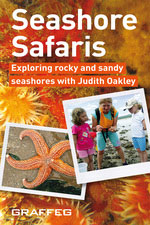

July 2010
SEASHORE
SAFARIS
 |
 |
Publisher:
Graffeg
Publisher's
Review (click on this text)
Review
by the City and County of Swansea
Seashore Safaris, a book written by Judith Oakley, (freelance marine biologist/consultant and Marine Biodiversity Officer at the City and County of Swansea), is a photographic guide that highlights some of the tiny animals you can find on the beach if you look in the right places on a rocky or a sandy shore.
This activity book is more than a species identifier, Judith shows you how to get started, what to take with you, where to look on the shoreline, how to recognise species and record findings and handy hints to help conserve the delicate ecosystem of our coastline.
Recommended.
Full review in the next issue of Torpedo
PERSONAL REVIEW: (FIRST DRAFT)
This is the book I should have written (and I dare say a few others as well) and is a much needed introduction to the world of the seashore and the hobby of rockpooling. It is a photographic guide to most of the common species encountered which is much appreciated as newcomers and even experienced rockpoolers will try and match up what they have seen to a visual image (and photographs work better than line drawings) and this will usually get them the correct species, (unless there are two very alike species and then you will need a specialist identification guide like the Collins Guide to the Seashore).
However, the seashore is a rich and interesting habitat with a myriad of species and 225 pages of this large pocket guide are comprehensively covered to suit the enthusiast.
Extract from the
foreword by Keith Hiscock:
"Being
able to names to what you see and, better still, to use your observations
to add to our knowledge about the natural world is what this book is about."
But the book for
a popular audience is more than this. It starts from the assumption that
the parents and teachers and older children are unfamiliar with the seashore
environment, so the
1. Getting started
explains about the
tides (very briefly: a detailed explanation can be in chapter 2) and the
equipment you may need, where and how to look for the seashore critters
(my term).
2. Living between
the tides
explains about the
dynamic nature of the littoral environment and the variations on different
coasts. It also introduces the explorer to a few technical terms which
are further explored in
3. Zonation
which is a rather
important explanation to on what part of the shore what animals and seaweeds
are to be discovered and why
4. Habitats
Even between the
zones the geography of the seashore varies and this chapter explains what
habitats what type of creatures
5. Beachcombing
This is the scavenger's
first introduction to the see what the sea has deposited on the strandline
complete with an excellent quick guide to the common shells and other treasures
6. Animal Life
The large animal
life section is structured roughly by phyla (major groups of animals) ignoring
for the most part the specialist microscopic studies. Each animal group
is given a brief description including behavioural characteristics. Each
animal is given a common name and the important scientific name (because
the common names can vary in different localities and in different books)
with a photograph, brief written description, habitat preferences and field
notes.
"Did you know?
Male crabs have
a narrow 'v' shaped tail with 5 joints and in females the tail is wider
with 7 joints."
Fish are the most
interesting discoveries for many of the fledgling rockpoolers. Most of
the common species are included but a frequently encountered species like
the Rock Goby, Gobius paganellus,
has been omitted.
7. Seaweeds
In contrast to the
fish the common macroalgae are well covered.
8. Conservation
This is a good section
encouraging participants to take an active interest, how the public can
help and a comprehensive list of where to report their findings.
9. Further Information
With a book list
and a list of organisations and their web pages, a comprehensive glossary
and an index, this has the hook that could result in a lifetime interest
in the seashore.
Now why would anybody want to go to Serengeti when we have so much of interest nearer to home?
RECOMMENDED PURCHASE *****